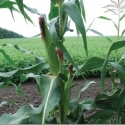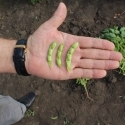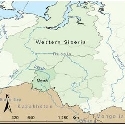10 Dec 2012
Potassium Nutrition for Small Grains Grown on Chestnut Soils
By V.N. Bagrintseva and V.V. Nosov

Stavropol Krai is one of the largest grain-growing regions in Russia. However, about 50% of its cereal grain output comes from areas that suffer from season-to-season fl uctuations in yield due to moisture defi cit. Soil and climatic conditions in these drier areas do allow for fairly high cereal yields if adverse weather conditions are avoided. However, insuffi cient precipitation, non-uniform distribution of rainfall between growth stages of cereals, soil drought, and hot, dry winds cause large reductions in yield. Since optimal mineral nutrition improves water use effi ciency in crops (Nikitishen and Lichko, 2007), balanced fertilization can be an effective method to increase yield and improve quality of grains in these dry areas.
Chestnut soils (Ustolls, Borolls, and Xerolls) occupy about 11% of arable land in Russia and are the fourth largest, in terms of area, after chernozems, grey forest soils, and soddy-podzolic soils (Russian Agriculture, 2010). The zone of chestnut soils is located in the northeastern and eastern parts of Stavropol Krai—located between the Black and Caspian Seas. Chestnut soils and their complexes with alkali soils (solonetz) and saline soils (solonchak) occupy 46% of the land area in the region (Antykov and Stomorev, 1970). The eastern part of Stavropol Krai is also characterized by small amounts of precipitation and non-uniform distribution of rainfall over the year. The long-term average precipitation in the area is 354 mm. Light chestnut soils are found in the driest area of the dry steppe zone and these soils have lower organic matter content compared to chestnut soils.
Soil K Availability in Chestnut versus Chernozem Soils
Chestnut soils and light chestnut soils generally have higher contents of water-soluble, available [extracted with (NH4)2CO3 solution], and so-called “easily exchangeable” K (extracted with CaCl2 solution), but lower non-exchangeable K (Table 1) when compared with chernozems (Bagrintseva, 1993).
A successive soil K extraction study (procedure according to Cherkasova, 1991) found the total amount of available K was 1.6 to 1.9 times higher in a chernozem soil than in chestnut soils (Table 2). However, for chestnut and light chestnut soils 68 to 76% of the total amount extracted was contained within the fi rst extract—a considerably smaller proportion was extracted in the fi rst fi ltrate taken from the chernozem. All available K in chestnut and light chestnut soils was extracted over 6 to 8 successive extractions, while extractable K appeared to level-off at a moderate rate of release even after a tenth successive extraction for the chernozem. It is apparent that chestnut soils could not sustain a rapid replenishment of available K from its slowly available forms in the same manner as chernozems. The content of available K in chestnut soils may, therefore, decline more rapidly than in chernozems under similar negative K balance (Cherkasova, 1991).
For a long time, research on effect of K fertilizer on winter wheat grown on chestnut soils did not receive adequate attention simply because of the common perception that chestnut soils had higher contents of available K than chernozems (Chelyadinov and Stomorev, 1964). This absence of experimental data to support the effi cient use of K fertilizer occurred within a period of declining soil K status in chestnut soils. In the face of decreasing levels of available K, declining arable land area (i.e., 201 to 400 ppm K2O using (NH4)2CO3 extractant), and increasing arable land area in low and medium classes (i.e., 51 to 200 ppm K2O) scientists were forced to recommend K fertilization in winter wheat to replenish K removed by harvest (Karandashov and Podkolzin, 1987). However, agronomists employed by agricultural enterprises did not follow them at the time since these recommendations offered no experimental evidence that K fertilizers had any effects other than maintaining available K levels.
Subsequent soil fertility surveys conducted by Podkolzin (2008) revealed trends in the dynamics of available K in chestnut soils in response to K fertilizer use (Figure 1). More signifi cant application of K began in the early 1980s until the mid-1990s. It was estimated that each 3 kg K2O/ha applied to winter wheat after bare fallow increased available K content in chestnut soils by an average of 1 ppm K2O. However, more recently, negative K balances have been commonplace with practically no use of K fertilizers, and this has already had a negative effect on available K content in these soils. Based on soil test results, it was concluded that the status of available K has returned to the initial level of the 1960s, when the use of K fertilizers fi rst began.
Effect of K Fertilizers on Yield and Quality of Small Grains
The Prikumskaya Research Breeding Station of the Stavropol Research Institute of Agriculture conducted a series of fertilizer experiments on chestnut soil with available K content between 250 to 300 ppm K2O (the so-called “increased” class ranges from 201 to 300 ppm K2O). It was revealed that K fertilizers, when properly applied, gave substantial yield increases in cereals and high grain quality (Bagrintseva, 1996). Field experiments were conducted mainly with the following crop rotation: bare fallow – winter wheat – winter wheat – bare fallow – winter wheat – winter barley. In these studies, P fertilizers were applied only to the fi rst winter wheat crop after fallow (i.e., twice per rotation). The repeated cropping of winter wheat is a rather common practice in agricultural enterprises of the region.
Potassium chloride fertilizer increased DM accumulation in winter wheat and winter barley through all stages of crop development (Table 3). The increase in DM yield of the second wheat crop after fallow due to applied K was relatively higher compared to the fi rst wheat crop, probably because soil K availability fell during the second wheat crop after fallow. The highest DM accumulation by the second wheat crop was obtained with 60 kg K2O/ha, which gave DM increases of 37%, 15%, and 10% at the tillering, heading, and grain fi lling stages, respectively. Interestingly, the positive effect of K fertilization on barley DM accumulation was visible through the years with different weather conditions. The application of only 30 kg K2O/ha to barley resulted in a DM increment of 27% at grain fi lling stage. Similarly, the application of fertilizer K had a positive effect on total and productive tillering capacity in the fi rst wheat crop after fallow, and hence, the number of tillers and heads per m2 (Table 4). Weight per m2 of straw, heads, and grain was also slightly increased due to K application. As a result, grain yield of the fi rst winter wheat after fallow increased by 0.26 t/ha (or 6%) due to K application of 60 kg K2O/ha (Table 3). The same rate of K gave a yield increase of 0.35 t/ha (or 12%) in winter wheat grown repeatedly. The effi ciency of K fertilizer use was high in winter barley with a yield increment of 14%. Taking into consideration such a high response of barley to K application in a relatively low rate, the agronomic reached 11.7 kg grain/kg K2O. It is estimated that K fertilizer use in winter wheat and winter barley could be profi table in 2011 if the AE of K exceeded 1.5 kg grain/kg K2O, excluding the costs of fertilizer delivery to the farm, fertilizer application, and additional harvesting and drying for the yield increment.
Studies on the residual effect of K fertilizer on grain yield of cereal crops do show an effect (Figure 2). Potassium fertilizers applied to the fi rst winter wheat after fallow slightly increased grain yield of the wheat crop grown repeatedly. The residual effect of K fertilizer was observed in winter wheat even in the fourth year after K application. Again, grain yield of winter barley increased in the fi fth year after K application probably due to the residual effect of highest K application of 120 kg K2O/ha. It is, therefore, important to take into consideration the uptake of residual K by cereal crops when planning nutrient management for the whole crop rotation. At the same time, the rate of applied K should not exceed 60 kg K2O/ha to exclude leaching and accumulation of K in subsoil horizons of chestnut soils because fertilizer K is weakly fi xed in topsoil layers of these soils.
Like with the positive effects of fertilizer K on grain yield and other yield attributes of small grains, K application also had a positive impact on grain quality (Table 5). Potassium improved grain fi lling for the fi rst wheat crop after fallow—the highest in a year when soil and atmospheric drought occurred during heading and grain-fi lling stages. The application of 60 kg K2O/ha to the fi rst wheat crop increased the test weight of grain from 709 to 727 g/l, 1,000 grain weight from 28.6 to 31.1g, gluten content from 20.5 to 21.5%, and the gluten deformation index from 36 to 46 units (data not shown). The results revealed the role of K in improving utilization effi ciency of N accumulated under bare fallow conditions as a result of soil organic matter mineralization. Fertilization with K was particularly effective in improving grain quality of the second wheat crop. Only N application (and residual P) to repeatedly grown winter wheat yielded low quality grains, while K application increased grain glassiness and gluten content. The highest increase (6%) in grain gluten content due to fertilizer K was observed in a year with adequate precipitation during heading and grain-fi lling stages. Grain of the second winter wheat crop after fallow met the “valuable” wheat quality class (gluten content of 23 to 27%) only with the balanced application of mineral fertilizers.
Summary
Fertilizer K application in chestnut soils helped to increase yield and quality of small grains. Application of K is more important for the second winter wheat crop after fallow as compared with the preceding wheat crop. It should be noted however that even when chestnut soils have so-called “increased” content of available K, measured using routine soil testing method, it is not guaranteed that plants will receive adequate K nutrition and produce the highest attainable yield. Perhaps soil test K interpretation classes need to be adjusted and updated for chestnut soils.
Dr. Bagrintseva is Head, Department of Maize Cultivation Technology,
Maize Research Institute, Pyatigorsk, Stavropol Krai; e-mail: maizetechno@
mail.ru. Dr. Nosov is Director, IPNI Southern and Eastern
Russia Region and is based in Moscow; e-mail: vnosov@ipni.net.
References
Antykov, A.Ya. and A.Ya. Stomorev. 1970. Stavropol. 413 p. (In Russian).
Bagrintseva, V.N. 1993. Buddenovsk. 29 p. (In Russian).
Bagrintseva, V.N. 1996. Postdoctoral Dissertation. Stavropol. (In Russian).
Chelyadinov, G.I. and A.Ya. Stomorev. 1964. In: Agrochemical characteristics of soils of the USSR (ed. A.V. Sokolov), Moscow, pp. 144-174. (In Russian).
Cherkasova, L.P. 1991. Ph.D. Thesis, Moscow. 24 p. (In Russian).
Karandashov, L.G. and A.I. Podkolzin. 1987. Stavropol. 69 p. (In Russian).
Nikitishen, V.I. and V.I. Lichko. 2007. Soil Fertility, 5: 9-11. (In Russian).
Podkolzin, A.I. 2008. Postdoctoral Thesis, Moscow. 45 p. (In Russian).
Russian Agriculture. 2010. Ministry of Agri. of Russia, Moscow. 54 p. (In Russian).




